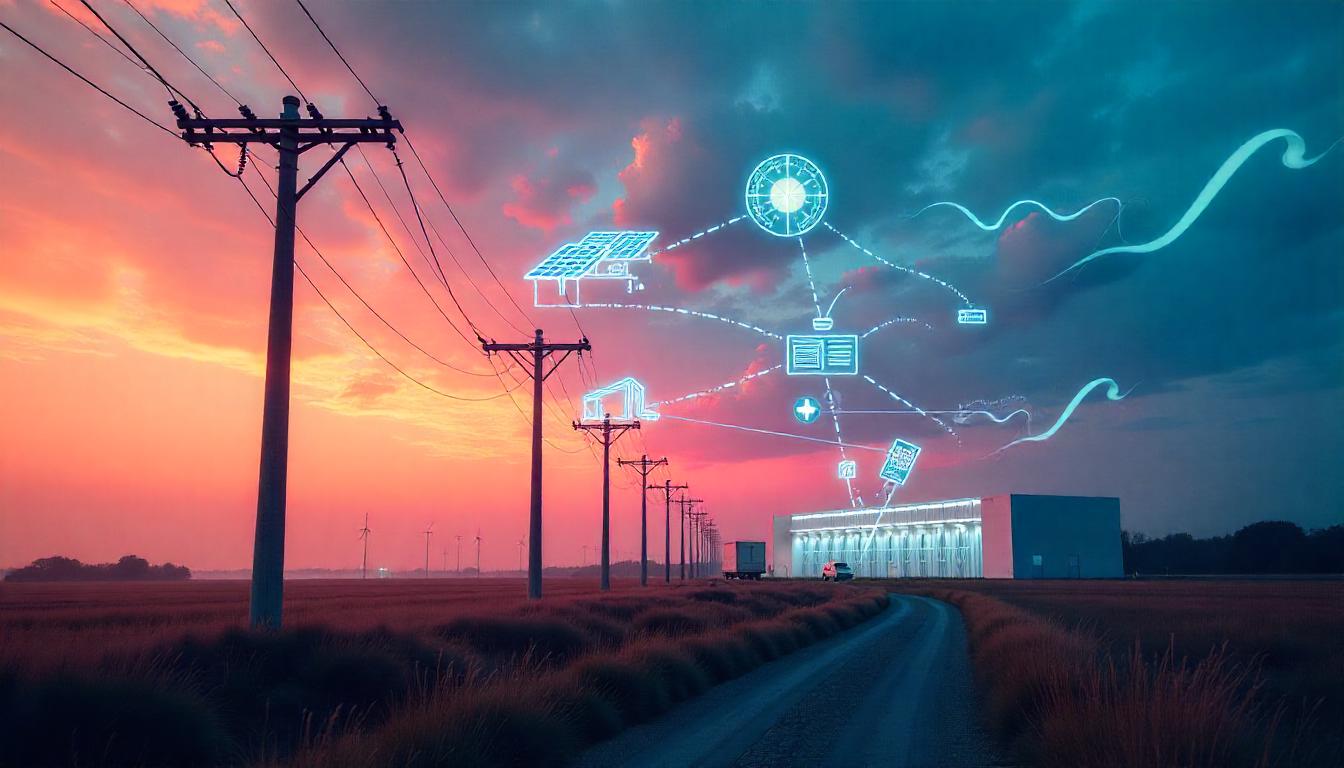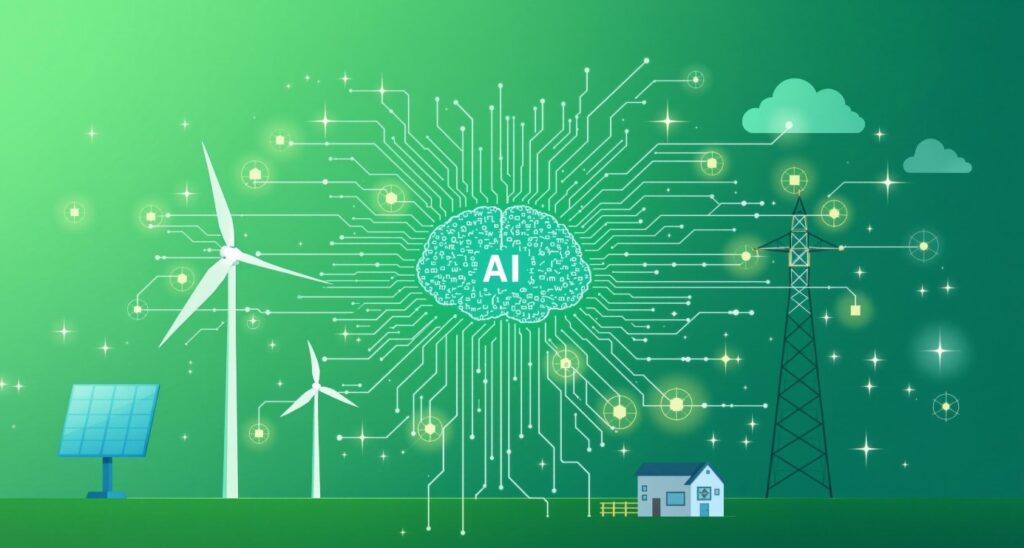Smart Power, Green Growth: How AI & IoT Are Forging Cambodia’s Energy Future

Smart Power, Green Growth: How AI & IoT Are Forging Cambodia’s Energy Future
Cambodia, a nation defined by its vibrant culture and dynamic development, is charting an ambitious course towards a sustainable future. At the heart of this transformation lies a profound shift in its energy landscape. No longer solely reliant on traditional sources, the Kingdom is rapidly embracing green energy, powered by an invisible revolution: the convergence of artificial intelligence (AI) and the Internet of Things (IoT).
While Cambodia’s green energy transition is accelerating with impressive renewable energy potential, particularly in solar and hydropower, integrating these diverse and often intermittent sources efficiently presents a complex challenge. This is where cutting-edge solutions like AI and IoT step in, acting as the digital backbone for a smarter, more resilient grid. This article will delve into how these powerful technologies are synergistically empowering Cambodia’s renewable energy sector, driving unprecedented efficiency, significant cost reduction, and enhanced grid stability. We’ll explore their specific roles, illustrate their combined impact, and highlight the key players actively shaping Cambodia’s green energy future.
- Smart Power, Green Growth: How AI & IoT Are Forging Cambodia’s Energy Future
- 1. Cambodia’s Green Energy Ambition: A Rapid Transition
- 2. The AI Advantage: Intelligent Powering of Renewables in Cambodia
- 3. The IoT Revolution: Connecting Cambodia’s Smart Energy Grid
- 4. Synergy in Action: How AI & IoT Drive Efficiency and Reduce Costs
- 5. On the Ground: Key Players & Initiatives Driving Digitalization in Cambodia’s Energy Sector
- Conclusion: Leapfrogging to a Digitally Powered Green Future
- Frequently Asked Questions (FAQs) About AI & IoT in Cambodia’s Green Energy
1. Cambodia’s Green Energy Ambition: A Rapid Transition
Cambodia’s journey towards a sustainable energy future has been remarkably swift. The nation has made significant strides in bolstering its power generation capacity while concurrently increasing its reliance on cleaner sources. This commitment is not just aspirational; it’s evident in tangible figures and clear policy directives.
As of 2024, renewable energy sources already account for an impressive 61.11% of Cambodia’s locally generated power, contributing to a total installed capacity of over 5,044 megawatts (MW). This remarkable achievement is largely driven by substantial investments in hydropower and a rapidly expanding solar sector. Furthermore, the nation’s electrification efforts have been highly successful, with approximately 99.15% of villages having access to grid power by the end of 2024.
Looking ahead, Cambodia’s ambitions are even bolder. The government aims to boost its clean energy generation capacity to 70% by 2030. This commitment is solidified in the Cambodia Power Development Master Plan (PDP) 2022-2040, a landmark policy that explicitly halts investment in new coal-fired power plants after 2024. The PDP projects a significant increase in solar power capacity, envisioning a leap from current levels to 3,155 MW by 2040, with wind energy also slated for integration by 2026. While this rapid transition is commendable, the inherent intermittency of solar and wind power, alongside the vulnerability of hydropower to climate-induced droughts, underscores the critical need for advanced technological solutions to ensure a stable and efficient grid.
2. The AI Advantage: Intelligent Powering of Renewables in Cambodia
Artificial intelligence is no longer just a concept of the future; it’s a vital tool actively transforming Cambodia’s energy sector. AI brings unprecedented levels of intelligence to power generation, distribution, and consumption, specifically addressing the complexities of integrating intermittent renewable sources.
One of AI’s most significant contributions is predictive maintenance. By analyzing vast datasets from solar farms, wind turbines, and grid components—including operational history, sensor readings, and environmental factors—AI algorithms can anticipate equipment failures before they occur. This proactive approach dramatically reduces unexpected downtime, prevents costly emergency repairs, and optimizes maintenance schedules, ensuring continuous energy supply.
Furthermore, AI enhances renewable energy forecasting. Accurately predicting the output of solar panels (dependent on sunlight) and wind turbines (dependent on wind speed) is crucial for grid stability. AI models leverage machine learning to analyze real-time weather patterns, historical generation data, and even satellite imagery, providing highly accurate predictions. This intelligent forecasting allows energy operators to seamlessly integrate fluctuating renewable sources, balance the grid, and efficiently dispatch power when and where it’s needed most, bolstering Cambodia’s efforts towards a robust Cambodia smart grid.
Beyond generation, AI plays a key role in optimized grid management and load balancing. AI-driven solutions analyze real-time data on energy demand and supply across the network, enabling dynamic adjustments to energy distribution. This capability helps prevent overloads, reduces energy waste, and enhances overall grid reliability, reducing the likelihood of blackouts. AI also optimizes energy consumption by analyzing patterns in industrial facilities and residential areas, identifying inefficiencies, and recommending tailored conservation strategies. Even in hydropower management, AI algorithms can optimize water flow through dams to maximize energy production efficiency while minimizing environmental impact and considering water resource management.

3. The IoT Revolution: Connecting Cambodia’s Smart Energy Grid
If AI provides the brains, the Internet of Things (IoT) provides the crucial nervous system, collecting and transmitting the vast amounts of data needed to power an intelligent energy ecosystem. IoT devices are the vital “eyes and ears” that are making renewable energy optimization in Cambodia a tangible reality.
At its core, IoT enables real-time data collection from every conceivable point in the energy grid. Sensors embedded in solar farms, substations, transmission lines, and even individual appliances constantly collect data on performance, temperature, voltage, and consumption. This continuous stream of information provides unprecedented visibility into energy production, distribution, and consumption patterns across the nation.
Smart meters, powered by IoT technology, are revolutionizing how consumers interact with their energy usage. These advanced meters allow residents and businesses to monitor their electricity consumption in real time, often via mobile apps. This instant feedback empowers consumers to make informed decisions about their energy habits, identify areas of waste, and actively participate in reducing their electricity bills, driving IoT energy efficiency in Cambodia.
Furthermore, IoT facilitates automated control and remote management of grid components. Operators can remotely switch circuits, adjust load balancing, and respond to anomalies with unparalleled speed and precision. This significantly improves grid responsiveness, enhances operational efficiency, and reduces the need for manual, on-site interventions, especially in remote areas. Crucially, IoT devices serve as the indispensable data backbone for AI. Without the continuous, granular data streams collected by IoT sensors, AI algorithms would lack the raw material needed for accurate forecasting, predictive maintenance, and intelligent optimization. The synergy between these two technologies is therefore profound: IoT collects the data, and AI makes sense of it to create a truly smart energy grid.

4. Synergy in Action: How AI & IoT Drive Efficiency and Reduce Costs
The true transformative power lies not just in AI or IoT individually, but in their seamless integration. This powerful synergy is precisely what’s driving unprecedented operational efficiency and significant cost reduction in green energy deployment across Cambodia.
The combined force of AI and IoT delivers unprecedented operational efficiency. AI-driven predictive maintenance, fed by real-time IoT data, means that unexpected breakdowns are dramatically reduced, leading to fewer costly emergency repairs and minimal service interruptions. Optimal energy dispatch decisions, informed by AI’s precise forecasting using IoT data, ensure that every generated kilowatt-hour is utilized efficiently, minimizing waste across the entire network. Remote monitoring and automated control, enabled by IoT, further streamline operations, reducing manual overhead and human error.
These efficiencies translate directly into significant cost reductions. Lower maintenance expenses are a direct result of proactive interventions. Reduced energy waste and the ability to detect anomalies or potential theft through intelligent monitoring contribute to overall system savings. Optimizing the utilization of expensive renewable energy infrastructure extends asset lifespan and maximizes return on investment. Ultimately, these gains in efficiency and reduced operational costs have the potential to contribute to more stable, or even lower, electricity prices for Cambodian consumers.
Beyond cost, this synergy significantly improves the integration of intermittent renewables. AI’s sophisticated forecasting capabilities, constantly fed by IoT data, help energy operators manage the variable nature of solar and wind power. This sophisticated management allows for a much higher penetration of these clean sources into the national grid without compromising stability, thereby reducing Cambodia’s reliance on often volatile fossil fuel imports. This, in turn, contributes to enhanced energy security, making Cambodia’s power supply more resilient and independent.

5. On the Ground: Key Players & Initiatives Driving Digitalization in Cambodia’s Energy Sector
Cambodia’s commitment to leveraging AI and IoT in its energy sector is backed by strong government policy and active participation from key institutions and private companies. This collaborative ecosystem is vital for building a robust Cambodia smart grid.
The Royal Government of Cambodia has laid a strong foundation through its Digital Economy & Society Policy Framework 2021-2035, which explicitly promotes infrastructure investments and the integration of AI into data analysis across various sectors, including energy. The Ministry of Mines and Energy also has its own digital strategy, aligning with these broader national goals.
Electricité du Cambodge (EDC), the state-run national utility, is central to this transformation. As the primary operator of Cambodia’s power grid, EDC is actively involved in modernizing infrastructure and exploring smart technologies to integrate renewables and enhance grid reliability. Their initiatives are crucial for the practical implementation of AI and IoT solutions.
Academic institutions are also playing a vital role. The Institute of Technology of Cambodia (ITC), through its Smart Grid Lab (SGLab), is at the forefront of research and development in intelligent power systems. Their work focuses on modeling, testing, and developing sophisticated algorithms essential for an intelligent grid.
The private sector is equally dynamic. Companies like Kamworks, a leading solar energy provider since 2006, are implementing large-scale solar farms and energy monitoring solutions that leverage IoT for data collection and performance analysis. VP.Start Technology is a notable local player explicitly focused on smart-grid system development and electrical grid automation across Cambodia. Their mission includes reducing electricity prices through innovative, sustainable, and reliable Smart Grid Solutions, with active R&D in IoT products and smart city applications. Similarly, SchneiTec Trading Co., Ltd., another significant player in Cambodia’s solar farm sector, provides Advanced Metering Infrastructure (AMI) systems for real-time data acquisition and power quality analysis—a direct application of IoT to enhance grid visibility. These companies, often partnering with international technology providers, are tangible examples of AI IoT energy projects in Cambodia taking root.
Conclusion: Leapfrogging to a Digitally Powered Green Future
The powerful convergence of AI and IoT is not merely an incremental improvement; it is a fundamental transformation for Cambodia’s green energy future. By embracing these cutting-edge technologies, Cambodia is accelerating its journey towards sustainability, building an intelligent, efficient, and resilient power grid.
Cambodia stands at a unique vantage point, poised to “leapfrog” traditional energy infrastructure development. Instead of incrementally upgrading outdated systems, it has the distinct advantage of building a modern, digitally powered green energy ecosystem from the ground up. This strategic approach positions the Kingdom as a potential regional leader in sustainable energy innovation, demonstrating how cutting-edge technology can address challenges like grid stability and energy costs, ultimately fostering robust economic growth and enhanced energy security.
We urge continued investment, collaborative efforts, and strong policy support for the widespread adoption of AI and IoT in Cambodia’s energy sector. For businesses, investors, technologists, and policymakers, Cambodia represents a fertile ground for impactful green energy innovation. By collectively embracing this digital revolution, we can help Cambodia deliver a truly green, prosperous, and energy-independent future. The path ahead for green energy in Cambodia is undoubtedly smart, connected, and brilliantly green.
Frequently Asked Questions (FAQs) About AI & IoT in Cambodia’s Green Energy
- Q: How does AI help green energy in Cambodia?
- A: AI enhances green energy in Cambodia by enabling predictive maintenance for infrastructure, improving forecasting of solar and wind power, optimizing grid stability and load balancing, and helping to manage energy consumption more efficiently.
- Q: What is the role of IoT in Cambodia’s smart energy grid?
- A: IoT collects real-time data from across the energy grid using sensors and smart meters. This data provides crucial visibility, enables automated control of components, empowers consumers with usage insights, and forms the essential data backbone for AI analysis and optimization.
- Q: What is Cambodia’s target for renewable energy by 2030?
- A: Cambodia aims to increase its clean energy generation capacity to 70% by 2030, with significant expansion planned for solar and future integration of wind power.
- Q: Which Cambodian companies are involved in smart grid and green energy technology?
- A: Key players include Electricité du Cambodge (EDC) in grid modernization, academic institutions like ITC (Smart Grid Lab), and private companies such as Kamworks (solar monitoring), VP.Start Technology (smart-grid systems, IoT products), and SchneiTec Trading (smart metering, solar farms).
- Q: How do AI and IoT help reduce costs in Cambodia’s green energy sector?
- A: They reduce costs by improving operational efficiency through predictive maintenance and optimized dispatch, minimizing energy waste and potential theft, extending the lifespan of infrastructure, and enabling higher penetration of cheaper renewable sources, ultimately leading to more stable or lower electricity prices.



